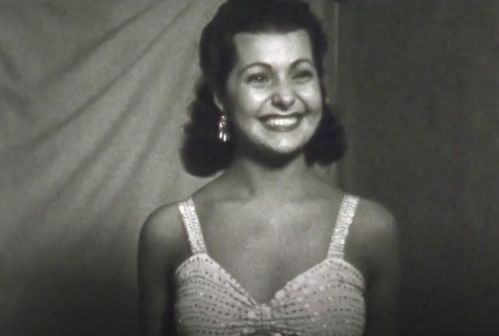
Neighbors Making History: Lorraine DeWood, aka "La Tirana"
(written by Jeff Rand, retired Adult Services librarian)
Lorraine DeWood was born into La Crosse’s Syrian-American community in 1920. After leaving La Crosse as a child, the beautiful and talented DeWood had a modest career as an entertainer. But it was her personal life that thrust her briefly into the national spotlight shortly after World War II. “La Tirana Diabla” (“The Devilish Tyrant,” screamed the tabloid headlines) gained notoriety for her tangential connection to a love-triangle murder in Cuba.
Lorraine DeWood, 19 years old in 1939 (screenshot from Internet Archive)
The first Syrian immigrants came to La Crosse about 1895. By 1915, 350 mostly Lebanese-Syrians lived in the Mill Street (later known as Copeland Avenue) area of La Crosse’s northside in what was known locally as the Syrian Colony. These families became part of the fabric of the community, and many of the family names are still present today, including Abraham, Asfoor, Markos, Monsoor, Patros, Skaff, and Wakeen. Lorraine DeWood came from the Abraham family.
Her father, Albert Robert Abraham DeWood, was a son of Michael Abraham and Elizabeth (Gannon) Abraham. DeWood was the family surname, but Michael Abraham, being the oldest of his family, followed the Syrian custom of using his first name as the family surname. Albert retained DeWood as his surname, but his siblings used Abraham as their last names.
Michael and Elizabeth Abraham came to the United States in the 1890s. Michael Abraham first shows up in the La Crosse city directory in 1903 as a peddler living at 709 Mill Street. Available records for the next 25 years show Michael and Elizabeth moving frequently and Michael engaged in various occupations, including railroad worker, fruit salesman, peddler, and hotel keeper. By 1919, Michael and Elizabeth were living above 215 Pearl Street while Michael operated what was variously recorded as a restaurant, billiards hall, and confectionary on the first floor of the building. They remained here until they died almost four decades later.
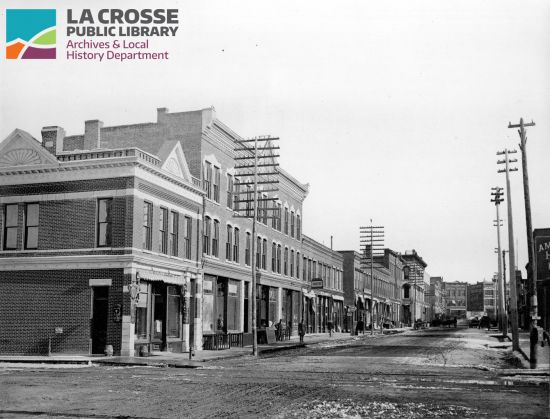
200 block of Pearl Street, looking east, in 1897
Their son, Albert Robert DeWood, was born in Syria in about 1894. When he was 19 years old, Albert married 16-year-old Sophia Boureston in 1913. Both of Sophia’s parents had been born in Syria, but she was born in Minnesota in about 1896. Curiously, Albert was not listed in the 1900, 1910, or 1920 censuses, with his family or with anyone else, nor is he in La Crosse city directories from 1890 to 1924. Albert first appears in the 1930 census after he and his family had moved to Milwaukee. Where was Albert R. DeWood in the early 1900s? Was Albert living with relatives in Syria, rather than with his family in La Crosse?
The 1930 census shows that Albert and Sophia DeWood immigrated to the United States in 1920. Their daughter, Loraine Farede DeWood, was born in La Crosse on June 15, 1920. They also had three other daughters and a son. One newspaper article stated they lived at 1100 Rose Street. The children, including Lorraine, attended a Catholic convent school in La Crosse before the family moved to Milwaukee in 1925.

Albert and Sophia DeWood supposedly lived on the northeast corner of Rose and Windsor Streets. Here is what the corner looks like today. (Photo by Jeff Rand, 30 May 2023)
Lorraine DeWood started in show business at the age of 13. While living in Milwaukee, DeWood learned to play the piano and violin, and she became a singer and dancer, all before she graduated from high school. She sang on local radio stations.
When Lorraine was 18 years old in 1938, she was chosen queen of the second annual Syrian-American Midwest conclave in Cedar Rapids, Iowa. From a group of six finalists selected at an earlier convention, movie star Tyrone Power picked Lorraine DeWood to ride in the place of honor in a twelve-float parade on Sunday, September 4, and be crowned at a coronation banquet and dance that evening. Besides her crown, Lorraine was presented with a large trophy and a bouquet of roses. One thousand Syrian-Americans participated in the festivities.
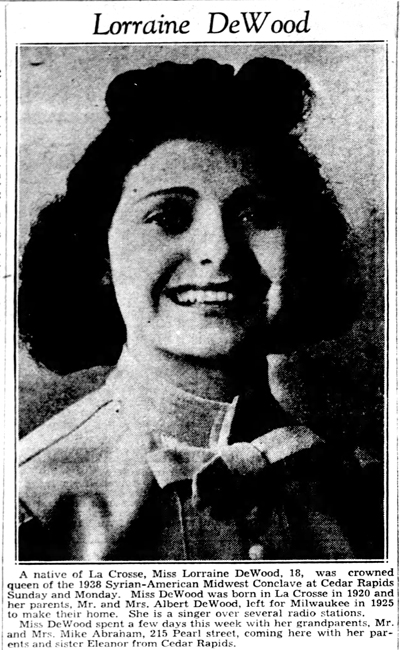
La Crosse Tribune 8 September 1938
Lorraine, along with her parents and one of her sisters, returned to her birthplace a couple days later. On September 7, 1938, she gave a singing performance at the White Front Night Club, owned by her cousin, Louis W. Abraham, at 213 Pearl Street in La Crosse. They remained in La Crosse for a few days with her grandparents, Mr. and Mrs. Mike Abraham of 215 Pearl Street.

La Crosse Tribune 6 September 1939
By 1940, 19-year-old Lorraine DeWood had moved to Beverly Hills, California, to be a professional singer. She crisscrossed the country for singing engagements in the New York City area, southern California, and points in between during the 1940s. One publication described her as a “glamorous torch singer.” One reviewer, noting that her act was “a smash hit,” wrote that DeWood “really sells a number and has plenty [of] class.” She also did a little modeling on the side.
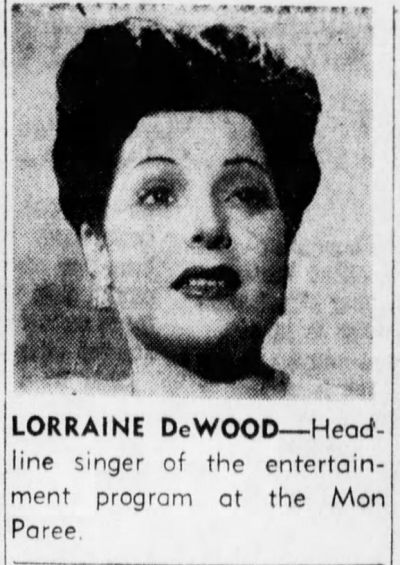
Brooklyn Daily Eagle 15 January 1943
By 1943, DeWood, the “Syrian Beauty,” had signed a movie contract with Columbia Pictures. She had an uncredited bit role in Song of the Open Road (1944) starring Edgar Bergen and his dummy, Charlie McCarthy. DeWood had another uncredited role in the Stan Laurel and Oliver Hardy comedy entitled The Bullfighters (1945). That appears to have been the extent of her movie career.
DeWood’s exotic beauty was an asset as an entertainer, but it may have also deflected from her singing talent. It was almost inevitable that that the personal life of a beautiful young entertainer would provide fodder for the gossip columnists. Walter Winchell mentioned “the dashing senator from Panama giving the rush to Lorraine DeWood the thrush” in 1941. Two years later, Winchell quoted a conversation in a New York nightclub between “an admirer” and DeWood. When the man said, “Gee, I pity the poor guy who gets you!” DeWood reportedly replied, “Never mind the poor guy . . . I pity the rich guy who gets me.” Dorothy Kilgallen asserted that DeWood was involved in a serious traffic accident in 1943 with “a famed West Coast figure (married)” in which she suffered “a broken jaw and the loss of most of her teeth.” Because of the California man’s power and influence, Kilgallen claimed, the badly injured DeWood was transported away from the scene before law enforcement arrived and the incident was hushed up.
But it was a love triangle played out with tragic consequences in Cuba’s Havana harbor that brought Lorraine DeWood to national attention.
John Lester Mee was a professional dancer and dance instructor in Chicago. Mee’s talents also included music composition and playing the piano, as well as speaking Spanish, French, and Italian. In late 1946, a book of his poems, some written during his Navy service, was published under the title Tirana Diabla.
Mee had been commander of a PT (patrol torpedo) boat in the Pacific Theater during World War II. Mee and a war buddy, Charles Jackson, bought a war surplus PT boat for $750 and converted it into a yacht they christened “La Tirana.” By the beginning of 1947, Mee and Jackson had anchored “La Tirana” in Cuba’s Havana Harbor.
A 21-year-old exotic dancer from Toledo, Ohio, named Patricia Schmidt (stage name Satira), who was performing in Caribbean nightclubs, joined them in residence on the boat. Schmidt had met Mee a year prior in a Chicago nightclub where she was dancing. Schmidt and Mee shared a cabin, and the relationship was going so well that the 72-foot boat was soon rechristened “Satira.” Schmidt later said, “We were terribly in love,” and Mee promised to marry her.
In mid-March, Schmidt happened to pick up some letters that revealed the 33-year-old Mee was already married. Inevitably, arguments and tension ensued, and Schmidt claimed that Mee beat her. On April 8, 1947, Mee ordered her to pack her things and get off the boat immediately. Schmidt claimed Mee knocked her down twice and threatened to kill her. Schmidt picked up a .22-caliber revolver and “blindly” fired one shot into Mee’s head, nearly severing his spinal cord. According to her, Mee said, “Kill yourself. I’m going to die and I want you to die in my arms.” Schmidt put another bullet in the revolver, intending to fulfill Mee’s Shakespearean tragedy scenario, just before Jackson rushed in and took the gun away from her. Mee was taken to a hospital where he died on April 13.
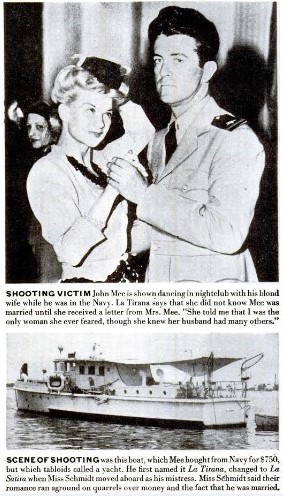
John Mee with his wife, Mary Dixon Mee, and his yacht, from Life Magazine 5 May 1947
Lorraine DeWood was implicated in the story because she had ended a romantic involvement with John Lester Mee just months before he was killed. DeWood said she met Mee in New York City in 1941 and fell in love with him. Mee gave her the nickname “La Tirana” (Spanish for “The Tyrant”) in one of his poems. He also wrote about her in his diary. The New York Daily News obtained that diary, and DeWood’s love affair with Mee became fuel for the sensationalist press.
In an April 22, 1947, interview in New York, DeWood said their affair ended in September 1946 after she received a letter from his wife, Mary Dixon Mee. Mee and DeWood had known each other for six years at that point, but DeWood decided to break off the relationship and burned the 103 letters that Mee had sent her over the years.
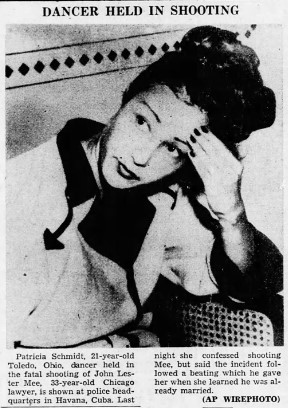
The Decatur Daily Review 15 April 1947
DeWood said, “It’s terrible to realize John is dead, . . . but I feel awfully sorry for the girl. She’s in a terrific spot.” She also said Mee was “the strangest and yet most wonderful man I ever knew. He was worth being in love with for a while. [But] I also felt that in him was another man---a man who could be cruel, even sadistic.”
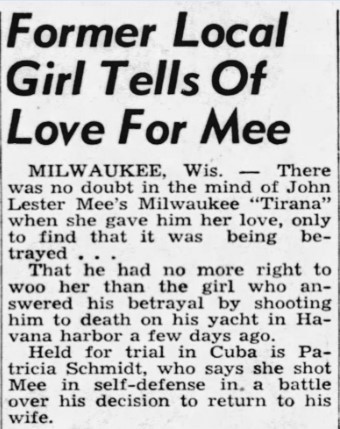
La Crosse Tribune 22 April 1947
DeWood became an object of tabloid curiosity because of her past involvement with Mee. People flocked to see her perform in New York City’s Greenwich Village Inn just days after Mee died. A reviewer noted “the craning necks and staring curious eyes” of the crowd who had come to see in person the love interest of a now-famous victim. Her looks and heritage added to her allure. The reviewer described her as “a fine figure of a woman,” with “thick, raven hair off to one side, flashing dark brown eyes” that embodied an image from Mee’s passionate diary entries about “The Tyrant.” Her voice was described as “husky, full-throated . . . with a faint Oriental quality that might be traced to her Syrian ancestry.” Despite the feverish attention, DeWood was described as relaxed and poised.
Life magazine sent a reporter and one of their top photographers, Ralph Morse, to her Greenwich Village show. In a two-page story in its May 5, 1947, issue, the somewhat sardonic text and photo captions marveled at the sudden fame of a hitherto-almost-unknown nightclub singer, who was performing in “a second-rate Milwaukee nightclub” at the time of Mee’s death, plucked from obscurity by a New York nightclub promoter who “put her on display at $1,250 a week.”
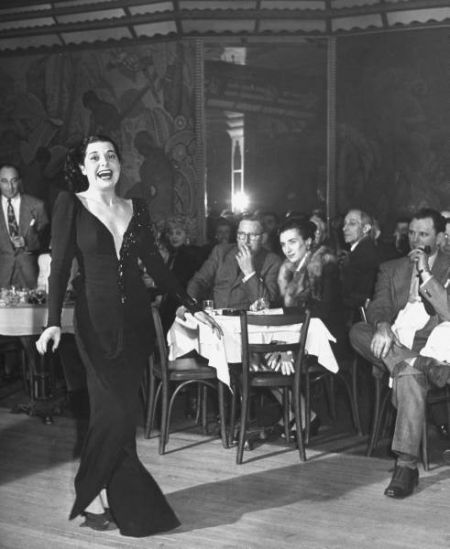
Even after the media blitz had died down, Schmidt still had to face justice. Her story that the killing was a case of self-defense did not convince a Cuban court, and she was found guilty of premeditated murder. A three-man tribunal sentenced her to 15 years in prison. Schmidt spent about a year in prison before being pardoned, in late 1948, by Cuban President [Ramon] Grau San Martin.
Lorraine DeWood was probably relieved when the glare of the national media spotlight dimmed enough for her to resume a normal life. Unfortunately, there are few sources that give information on the next sixty years of her life.
On May 23, 1948, Lorraine DeWood married Harold Wadro, a New York City physician. He was 33 years old at the time, and Lorraine was just shy of her 28th birthday. On September 10, 1948, Lorraine (DeWood) Wadro gave birth a girl, Kathy Wadro. Harold and Lorraine had a son, David, born on April 1, 1952. Another daughter, Cynthia Wadro, was born on January 10, 1956. Dr. Wadro died unexpectedly in 1963; Lorraine re-married in 1989 to Thomas C. Sofia in New York City.
Lorraine Farede DeWood Wadro Sofia lived to be 90 years old. She died on September 28, 2010, in New York City. She was buried in Maple Grove Cemetery at Kews Gardens, in Queens County, New York, where she shares a grave marker with her son, David, one of her daughters, Cynthia, and a grandson.
Lorraine DeWood, the Syrian-American girl from La Crosse, Wisconsin, who became famous, but not in the way she wanted (photo by Helen Day, Find-a-Grave.com)
WANT TO LEARN MORE?
Check out Jeff's full article here

